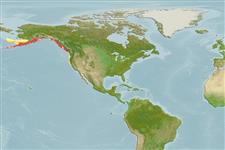Teleostei (teleosts) >
Perciformes/Zoarcoidei (Eelpouts and pricklebacks) >
Cryptacanthodidae (Wrymouths)
Etymology: Cryptacanthodes: Greek, kryptos = hidden + Greek, akanthoides = similar to thorns (Ref. 45335); giganteus: From the Latin gigantea, meaning 'huge' (Ref. 27436).
Environment: milieu / climate zone / depth range / distribution range
Ecology
Marine; demersal; depth range 6 - 128 m (Ref. 12204). Temperate; 60°N - 38°N, 175°W - 120°W
Northeast Pacific: southeast Bering Sea to northern California, USA.
Size / Weight / Age
Maturity: Lm ? range ? - ? cm
Max length : 117 cm TL male/unsexed; (Ref. 12204)
Short description
Identification keys | Morphology | Morphometrics
Found on soft bottoms (Ref. 12204). Probably spends part of its life buried (Ref. 12204).
Life cycle and mating behavior
Maturities | Reproduction | Spawnings | Egg(s) | Fecundities | Larvae
Coad, B.W., 1995. Encyclopedia of Canadian fishes. Canadian Museum of Nature and Canadian Sportfishing Productions Inc. Singapore. (Ref. 12204)
IUCN Red List Status (Ref. 130435)
Threat to humans
Harmless
Human uses
Tools
Special reports
Download XML
Internet sources
Estimates based on models
Preferred temperature (Ref.
123201): 4.1 - 10.1, mean 6.8 °C (based on 180 cells).
Phylogenetic diversity index (Ref.
82804): PD
50 = 0.6250 [Uniqueness, from 0.5 = low to 2.0 = high].
Bayesian length-weight: a=0.00389 (0.00180 - 0.00842), b=3.12 (2.94 - 3.30), in cm total length, based on all LWR estimates for this body shape (Ref.
93245).
Trophic level (Ref.
69278): 3.1 ±0.1 se; based on size and trophs of closest relatives
Fishing Vulnerability (Ref.
59153): High to very high vulnerability (70 of 100).
